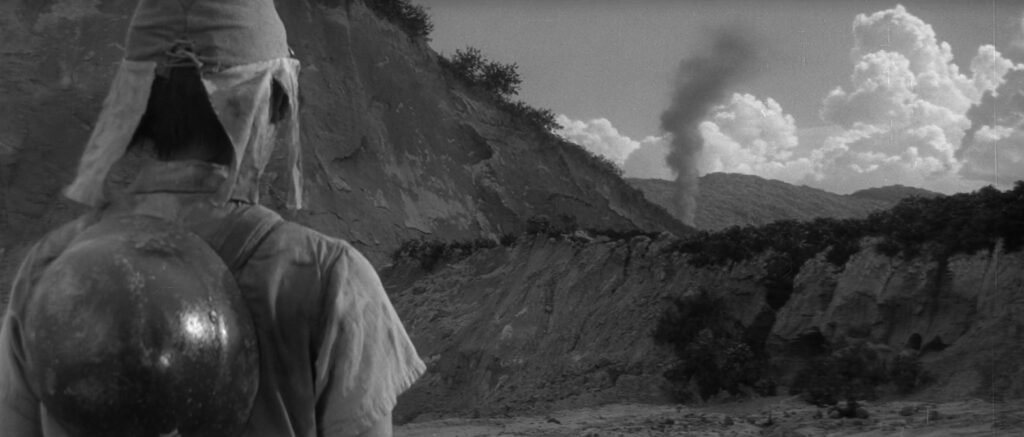
Fires on the Plain
1959, directed by Kon Ichikawa
The title of Fires on the Plain alludes to a recurring mystery that hovers around the edges of its plot. Are the distant fires in the valleys of Leyte smoke signals sent up by Filipino guerrillas, or are they ordinary bonfires? At the end Tamura concludes that they’re just farmers burning chaff, but we can’t quite dismiss the first interpretation. The fires are indeed signals, not necessarily for guerrillas but for us, pointing to a meaning beyond the obvious anti-war message.
Private First Class Tamura, the weary, starving, consumptive protagonist, reveals the fires’ meaning in his final line. To him they represent a normal life, so different, he hopes, from the ordeal of World War II, and after reaching the limits of horror he walks straight toward one of the bonfires. Another soldier had remarked earlier that Japanese farmers make those fires too, likewise linking them to normal life. If the fires represent normality to Tamura, might not the film itself, however abnormal its reality may be, say as much about everyday peacetime existence as about the dehumanization of war?
The vision of “normal life” that finally attracts Tamura to the bonfire proves fatal, after the violence of war had failed so many times to kill him. But what could be so terrible about ordinary life that it should be analogous to the nightmarish picture of war in Fires on the Plain? To be fair, the film does not try to confront us with the full horrors of warfare or shock us with gruesome suffering. Its hardships are mostly cumulative: fear, hunger, thirst, disease, despair, exhaustion, filth, discomfort – and when it shows violence it tends to distance the viewer through surrealism or black humor. A column of soldiers hits the ground under enemy fire, and the surviving half rises to continue their trudging march, almost comically, as if death were routine. A dead soldier lifts his face out of the mud to ask a living soldier to repeat himself. The film’s connection to reality does not lie in its verisimilitude, but in a pattern that speaks through its peculiar details.
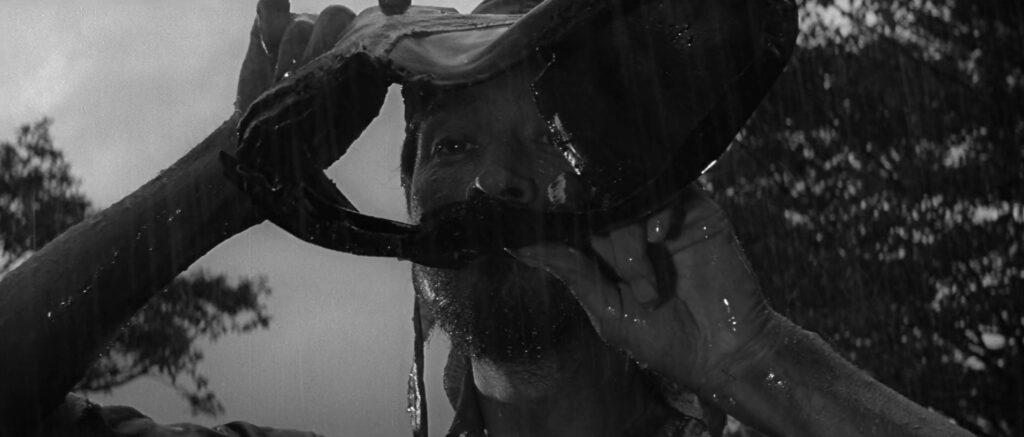
In one famous vignette, a soldier exchanges boots with a dead comrade and leaves his severely tattered old boots by the trail. Another soldier comes along with even shabbier footwear and switches boots in the same manner. Tamura follows behind, examines the rejected boots, decides that his are equally desolate, and walks off barefoot. The scene is notable for both its simplicity (told largely via close-ups) and its dry humor, but it’s also a window into the film’s logic. The soldiers are “trading up” until the last one is left with nothing. Like so many sequences in Fires on the Plain, it’s an illustration of economics.
Economics governs the film from the start, when the squad leader orders Tamura to commit suicide if the hospital won’t take him. Like a worker who’s no longer useful, he is dispensable to his superiors and to his company. Henceforth the film will be preoccupied with supply and demand as desperate soldiers struggle and compete for hospital beds, food, water, salt, and clothing. The emphasis on salt in particular harkens back to the commodity’s ancient use as a medium of exchange which left us the word “salary”. Yasuda hordes tobacco leaves to prop up their value, enlisting Nagamatsu to dole them out one by one to passing soldiers in exchange for basic necessities. The relationship between Yasuda and Nagamatsu is transactional, one a capitalist and the other exploited labor. The specter of cannibalism, which surfaces increasingly often, is a transparent metaphor for cutthroat competition in an economy of limited essentials, a zero-sum game where every winner necessarily creates a loser, and a society feeds on itself.
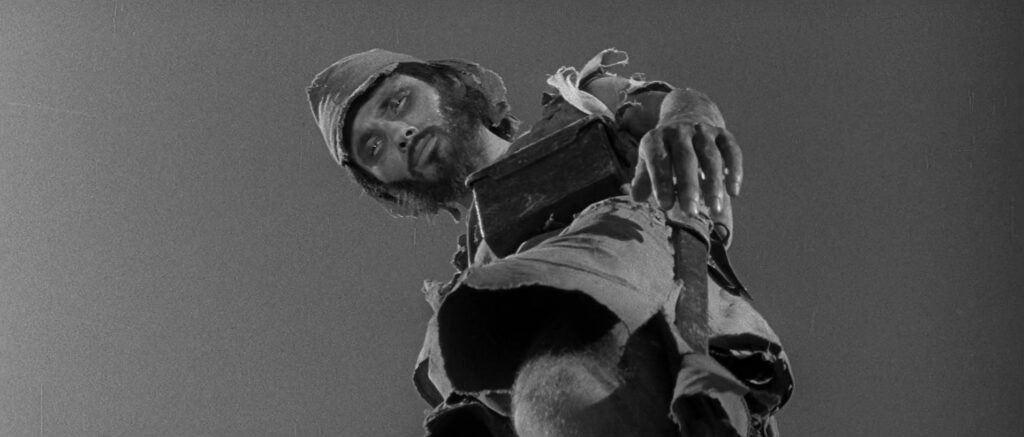
In 1959 Japan was well into its postwar “economic miracle”, and while standards of living were rising, it was nevertheless a social upheaval whose progress relied on competition. A losing army’s death march through a war zone makes a fitting metaphor for the experience of people left behind in such an economy. The soldiers on Leyte are virtually stranded, left behind by the country they’ve served, and Tamura all the more so because of his tuberculosis. There is a promise of evacuation to Cebu if they can reach Palompon, but the obstacles are formidable, as they likewise would be for “uncompetitive” individuals in the modern economy.
Fires on the Plain shows advanced economic insight in rejecting the assumption that human behavior is rational. Time and again characters act against their self-interest, behave inconsistently, follow raw emotions, or leave decisions to chance. On his trek to the hospital Tamura inexplicably leaves his six rationed yams on the ground and nearly kicks them aside before packing them again. He lets a falling stick choose his path. When he shows a civilian couple that he’s not a threat, the woman keeps screaming, triggering him to shoot her in panic. A soldier surrenders to the Americans only to get shot dead by a Filipina accompanying the Yanks. Irrationality mounts to full-scale madness when Tamura meets a soldier under a dead tree expecting an autogyro to airlift him home. If human rationality is so undependable in war, how sure can we be that there isn’t also a kind of madness behind the peaceful competition driving an economic boom?
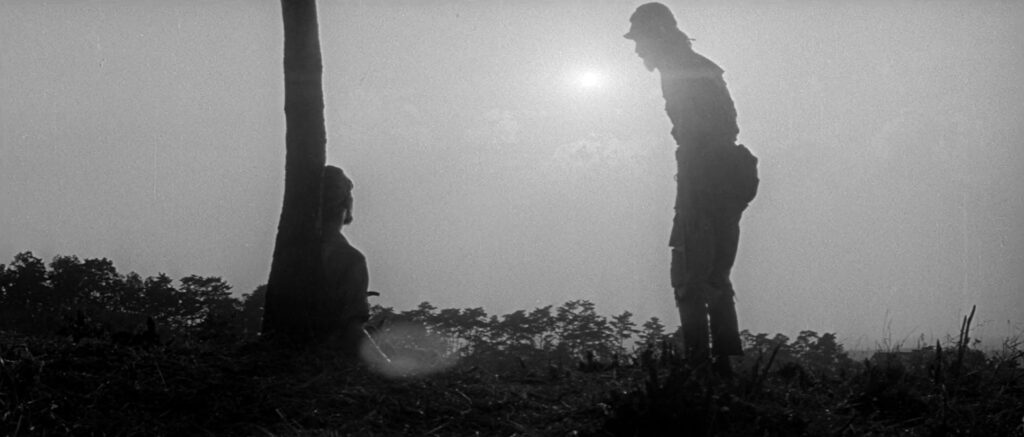
By characterizing the horrors of competition through the lens of warfare, Fires on the Plain says what cannot be said directly – that there’s something frightening about normal life in the modern economy. The film doesn’t exaggerate by equating the hardships of war with the hardships of peacetime, nor does it pursue an airtight economic argument. Instead it asks us to consider whether there isn’t a continuum between the cruelty and madness of war and that of normal life. Once we see the unexpected analogy between wartime and peacetime, we can also reverse the arrow and return the film – with greater insight – to its original status as an anti-war statement. In other words, when we see the continuum between economic horrors and the nightmare of actual war, we can better understand the causes and nature of war, how war itself is an extension of the aggressive and inhumane competition so often exalted during peacetime.
Fires on the Plain thus has a dual nature, both as an anti-war movie and as a comment on the warlike characteristics of normal life in 1959. As if priming us to see this duality, the movie is filled with doublings. Nearly everything that happens, happens twice. In the opening line the squad leader calls Tamura an idiot and says he cannot stay at the base; at the hospital another officer calls him an idiot and says he cannot stay there. Twice Tamura picks up salt in an evacuated village and has to rush off because a Filipino native escapes him and might return with firepower. Both entering and leaving the seaside village Tamura exclaims “Japanese soldiers!”, once in horror at the bodies piled by the church, once in relief at three soldiers on a hillside. A severed hand in a field echoes another hand rising grotesquely from the piled corpses at the church. On his journey Tamura falls in with two parties of soldiers, each led by a bully, each prone to cannibalism. Tamura drops his rifle in a river after killing an innocent woman, and he lays Nagamatsu’s rifle on the ground after killing him in disgust. After both the hospital shelling and the tank assault he surveys a field strewn with corpses. In two consecutive scenes one soldier approaches another seated at the base of a lone tree. Tamura recoils from the mad soldier whose beard gleams with devoured excrement, and he recoils from Nagamatsu whose beard gleams with Yasuda’s blood. All of these dualities are further reflected in the dual interpretations of the distant fires.
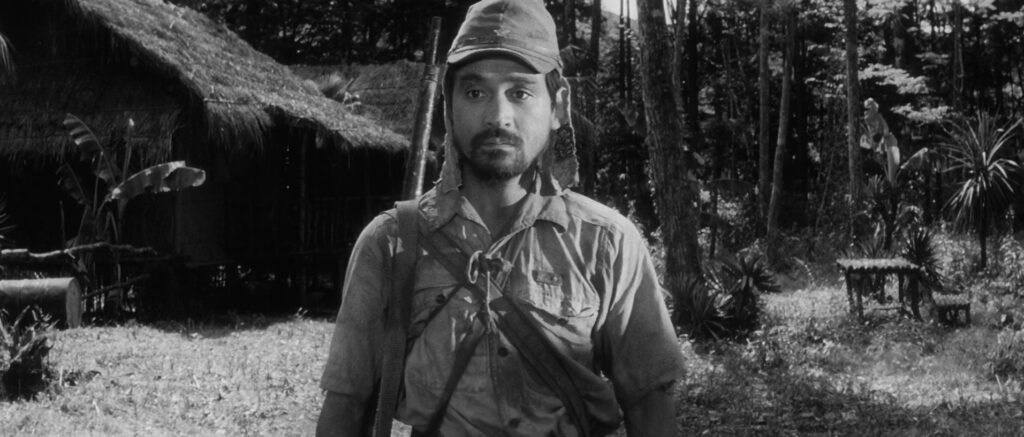
By 1959 Japan was building a new identity, asserting itself as a peaceful modern nation in place of its recent imperialist past. The point of Fires on the Plain is not to set Japan on a new course, but to reinforce the pacifist values it professed. More than providing answers, it asks questions. If we channel our warlike impulses into production and commerce, are we creating a better world or perpetuating the madness of war? How can we shape our economy so that no one is written off as cruelly as Tamura is, sent off alone into the jungle with a grenade to blow himself up?
CONNECTIONS:
Ugetsu monogatari – Past wartime as a metaphor for Japan’s increasing commercialization
The Burmese Harp – Title object has dual purpose: its intended use, and as a signal in war
The Exterminating Angel – Numerous repetitions; surrealism with a social purpose; disembodied hand
The Cook the Thief His Wife and Her Lover – Cannibalism as a metaphor for cutthroat capitalism
Black Hawk Down – Ordeals of warfare give rise to an argument on a topic broader than war itself